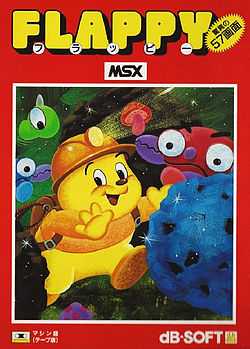Flappy
| Flappy | |
|---|---|
 | |
| Developer(s) | dB-Soft |
| Publisher(s) | dB-Soft |
| Platform(s) | FM-7, MSX, Nintendo Famicom, PC-6001, PC-8801, Sharp X1, Virtual Console |
| Release date(s) | FM-7 JP 1983 MSX JP 1984 Famicom JP June 14, 1985 PC-6001 JP 1983 PC-8801 JP 1983 Sharp X1 JP 1983 Game Boy JP 1990 Virtual Console JP July 3, 2007 |
| Genre(s) | Puzzle game |
| Mode(s) | Single-player |
| Distribution | ROM Cartridge |
Flappy (フラッピー Furappī) is a puzzle game by dB-Soft in the same vein as the Eggerland series and Sokoban that is obscure outside of Japan. It features Flappy, a somewhat mole-like character who must complete each level by pushing a blue stone from its starting place to the blue tile destination.
Flappy first appeared on the Sharp X1 home computer in 1983. This debut was soon followed by with conversions to a number of popular Japanese computers in the early 1980s, including the NEC's line of PCs and the Fujitsu FM series. As a puzzle game, it was well suited to these early systems since it didn't require a tremendous amount of graphical sophistication. Ports for the MSX computer line and the Nintendo Famicom were released in 1985.[1] DB-Soft produced a sequel with more difficult puzzles called King Flappy for the benefit of anyone who managed to clear the original 200 levels. A Nintendo Game Boy port was released exclusively in Japan in 1990 and was published by Victor Musical Industries.[2] Over time, Flappy has continued to see many graphically improved upgrades, such as on the Windows platform and on several mobile phone devices. [citation needed] It was released on Japan's Virtual Console in 2007.
Two officially-unreleased variants of Flappy, Floppy and Beyond Floppy, were programmed by Greg Hale and Ted Cohn for the Apple II platform.[3] Floppy featured special names for each of the game's levels. Included with both Apple II games was an editor which allowed the user to create their own custom levels.
Storyline
The beautiful planet of Blue Star, home-planet to a young boy named FLAPPY, is invaded by Dark Emperor Ngalo-Ngolo. The proud inhabitants of Blue Star, wanting neither war nor the invasion, self-destruct along with the planet on a path of self-determination. FLAPPY, however, is boarded onto an escape capsule headed for neighboring Planet Seviras by his father and so survives. From his capsule he sees fragments of the exploded Blue Star rain down incessantly on Planet Seviras.
Wandering aimlesslessly about Planet Seviras, FLAPPY reaches an oasis where he suddenly hears a voice from the sky saying, 'Gather up the fragments of Blue Star, the Blue Stones, to this Blue Area. When all of them have been gathered...' FLAPPY, believing a miracle has just occurred, begins on a journey to gather all the Blue Stones.
Gameplay
Gravity, gaps in the floors, and wandering enemies stand in the way of Flappy reaching his goal. Flappy can pick up and throw sleeping mushrooms at the enemies to knock them out for a while, or drop stones on them to crush them permanently. There are, however, many obstacles along the way: brick walls you must work your way around, brown stones which you can crush but which can also crush you if they fall on you, holes or dead angles in which the blue stone becomes unretrievable if it falls into them, and moving enemies. The game features just two enemies: Unicorns and Ebira. Unicorns are green creatures that move in mostly-repetitive horizontal patterns. Ebira are red crab-like enemies (the word "ebi" is a Japanese term for shellfish) that relentlessly chase Flappy both horizontally and vertically. Ebira tend to mimick Flappy's movements, so Flappy must be careful to avoid being charged by a persistent Ebira.
Ports and sequels
- Flappy
- Sharp X1 (1983)
- Sharp MZ-800 (1984)
- PC-6001mkII ・FM-7 ・PC-8801 ・PC-8001mkII (1984)
- MSX (1985) (as Flappy Limited '85)
- Nintendo Famicom (1985)
- PMD 85 (1988)
- i-mode (2004)
- Yahoo! Mobile (2005)
- Virtual Console (2007)
- King Flappy
- Sharp X1 ・PC-8801mkIISR ・PC-8001mkIISR (1985)
- Flappy 2: The resurrection of Blue Star
- X68000 (1989)
- Flappy Special
- Nintendo Game Boy (1990)
- Flappy for Windows
- Microsoft Windows (1995)
- FLAPPY95
- Microsoft Windows (1996)
- Flappy World
- Microsoft Windows (2001)
References
- ↑ Famicom Games, Famicom World.
- ↑ Flappy Special, Gamekult.com.
- ↑ Thread on chi.general.
External links
- Flappy guide at StrategyWiki
- Picture solution guide to all 200 Famicom levels (Japanese)
- Video solution guide to all 200 Sharp MZ-800 scenes (part 1, part 2, special effects)